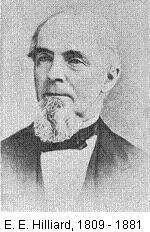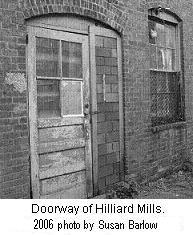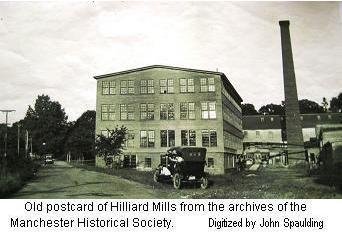
REPRINTS

You can still go to Hilliardville. Just drive west on Hilliard Street, and when you get to Adams Street, you�re in the
center of Hilliardville. But it�s no longer a little village, and the Hilliard Mills no longer clatter away producing wool.
You can see old mills, one of which is the oldest surviving manufacturing building in Manchester, according to Herb
Bengtson, retired Town Historian. Built in 1834, it�s a long, low building, reused over the years for various enterprises,
including paintball supplies. This wooden building stretches back from Hilliard Street toward Bigelow Brook, one of the
sources of water power for Hilliardville�s old mills.
Before the area even got the name Hilliardville, it was a center of activity. Manchester�s first documented industry
was a nearby sawmill begun in 1672, with land granted by the General Assembly to John Allen.
Bigelow Brook, a historic source of water power, flows right into Hilliardville and meets the Hockanum River there.
Bigelow Brook sported the new industry of Aaron Buckland, who in 1780 founded a woolen mill, in which blankets were woven
for soldiers during the War of 1812. Mr. Buckland sold the mill in 1832 to Samuel Pitkin, who took in Elisha E. Hilliard as
a partner.

E.E. Hilliard (1809-1881) became sole owner in 1842, making the mills a family enterprise with his son, Elisha Clinton
�Clint� Hilliard, and Clint�s son, named E.E. Hilliard after his grandfather. The mills produced cloth for uniforms in the
Civil War.
The woolen mills set a record, according to the Spiess & Bidwell 1923 History of Manchester, Connecticut, for
�continuous operation in a single line of production that exceeds that of any other woolen manufacturing plant in the
country.� The Hilliards� property included �a large acreage stretching from Adams Street�east along Hilliard Street and
Middle Turnpike to the tracks of the South Manchester railroad. Much of this is wooded and borders several ponds, which
add a picturesque quality to the landscape. West of the mills, the land rises sharply and much of it is clothed with fir,
so that the plant lies in a sheltered nook in a locality beautified by nature as well as man.�
The Hilliards constructed a sprawling complex, with buildings added in 1882, 1892, 1896, 1901, and 1925. The mills used
water power from Hilliard Pond, a mill pond created by damming Bigelow Brook upstream, near the location of Bally Total
Fitness. Coincidentally, this pond also promoted fitness � it was used for swimming for many years. The pond area became
wetlands when the dam was taken down in the 1960s.
Hilliard Mills also used hydro-electric power from a plant on the Hockanum River off Adams Street. The ruins of the
power plant remain, although it was heavily damaged in the hurricane of 1938.
According to the Hilliard family biography, quoted in Old Manchester Storytellers, a 1995 Historical Society
book, old E.E. Hilliard could judge a piece of woolen cloth by the �feel.� When his son wanted to install a new
invention � telephones � between the various mill buildings, he is reported to have said with some reluctance, �Well,
Clint, go ahead and put it in, but you can�t feel a piece of cloth over that wire.� The biography describes E.E. Hilliard
as a �God-fearing, upright, honorable, tax-paying and successful citizen.� The inventory of his estate showed real estate
and other property appraised at $369,155.15, a tidy sum in 1881.
The Hilliards� enterprise was the backbone of Hilliardville, with 200 employees in 1923. It continued to produce men�s
and women�s clothing and fine woolen cloth until 1937, when it closed during the Great Depression.
In the 1940s, Pratt & Whitney reopened the factories for defense manufacturing, surrounding the area with a barbed wire
fence and placing a guard tower on the west side of Bigelow Brook.
After World War II, the Manchester Knitting Mills moved in. A young Nate Agostinelli worked in the shipping and
receiving department there in the late 1940s while attending Manchester High School. His classmate and future wife, Helena
Dare, worked in the office. The Knitting Mills had been located at Manchester Green, and eventually moved to Rockville.
Nate went on to become the mayor of Manchester and the President of Manchester State Bank.
In 1949, Bezzini Brothers bought the complex, and produced furniture there as Old Colony Furniture. Since then, tenants
have included offices, including Bezzini Realty, a furniture recycling business, and a piano restorer.
In 2006, Peter Bonzani and partners bought and began restoring Hilliard Mills. Their project has required monumental
work so far. You can see the result of their labors by clicking
www.hilliardmills.com.
Today, you need to use some imagination to piece together the remnants of the former industries. There are clues
throughout the grounds: the raceway leading from Bigelow Brook to the factories, vestiges of the old turbine, dye house,
smokestacks, and water towers. Instead of the former water-powered mills, the high-tech Purdy Corporation manufactures
aerospace parts in buildings just up the street.
If you have time to enjoy both nature and history, try visiting the area by parking at the corner of Hilliard Street
and New State Road, and walking along the short Hilliard
hiking trail maintained by the Hockanum River Linear Park Committee. From the end of it, you can see what remains of
historic Hilliardville.


All content copyright 2025, Manchester Historical Society, founded 1965. All rights reserved.